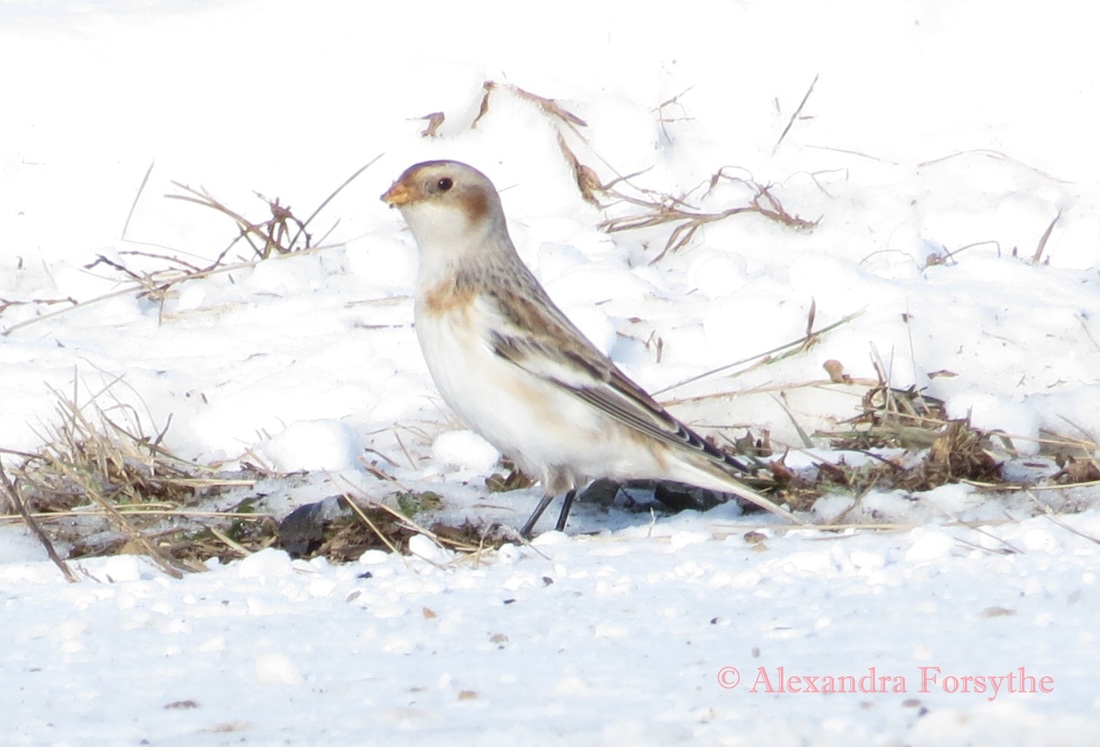As I write this, it is 17 degrees Fahrenheit outside. The eggs that my chickens and ducks laid in their heated coops are near the freezing point. Can you imagine a songbird trying to incubate an egg in such frigid temperatures? Imagine no more! Meet the Snow Bunting! These tough birds will play and sing in temperatures of -22˚F, and they choose to raise their young above the Arctic Circle. Their cheerful song and demeanor despite such harsh conditions has earned the respect and admiration of generations of birders.
“In his far polar home,... the only sound that breaks the all-enveloping silence for months at a time, is the snow-bunting’s sweet vibrant song, happy and musical as the tinkle of the mountain brook. Along in August..., the snow-buntings don their warmer buff and brown plumage, and begin to assemble in considerable flocks on the grassier slopes for the journey southward. Quiet and still, as if sad to leave their northern home, they feed about the rocks, lingering even until November, when the night comes on, and the sun no longer shines even at noonday. Then the North is silent until they come again.” - The Wilson Bulletin (June 1919).
In winter, most birders look for the brightly-colored winter finches and elusive owls. However, there are several species of incredible birds that visit Indiana in winter that are often overlooked. The Snow Bunting is one of these winter birds. Its simple but elegant brown-and-white coloration makes it very difficult to spot in the snow-covered fields which they usually inhabit.
Snow Buntings are typically found in Indiana in winter. They breed in the northernmost parts of Canada and Alaska - further north than any other songbird! They are also one of only four bird species that has been spotted near the north pole (the other three are Black-legged Kittiwake, Northern Fulmar and Arctic Tern). The males will migrate north to establish their territories long before the females migrate. The females do not migrate until four to six weeks later. When the males reach their breeding grounds, the nighttime temperatures will still dip below -22˚ Fahrenheit! To help keep the clutch warm, the nest is built in deep crevices within rocks and they line the nest with fur and feathers.
The Snow Bunting only has one molt per year. They molt in late summer at which time they get the brown-and-white coloring we are accustomed to seeing in winter. Their beautiful black and white breeding plumage is hidden underneath the brown coloring. To achieve his striking breeding plumage, the male Snow Bunting will scrape the brown feather tips off by rubbing them on the snow. By the time breeding season begins he will have his immaculate black-and-white coloring.
During 2013-2014's Christmas Bird Count, 1,948 Snow Buntings were reported in Indiana, with the bulk of them (1,745) found in the Pokagon State Park vicinity. Snow Buntings were the sixth most plentiful bird in Canada’s Christmas Bird Count the same year, with 101,541 individuals reported.
The cheery Snow Bunting has been loved by people for many years. Theodore Roosevelt wrote of the Snow Bunting:
“One bleak March day,...a flock of snow-buntings came...Every few moments one of them would mount into the air, hovering about with quivering wings and warbling a loud, merry song with some very sweet notes. They were a most welcome little group of guests, and we were sorry when, after loitering around a day or two, they disappeared toward their breeding haunts.”
To learn more about Snow Buntings, the banding and tracking efforts and other studies, check out the Canadian Snow Bunting Network on the web or Facebook via the Ruthven Park Bird Banding Station and Nature Blog.

 RSS Feed
RSS Feed
